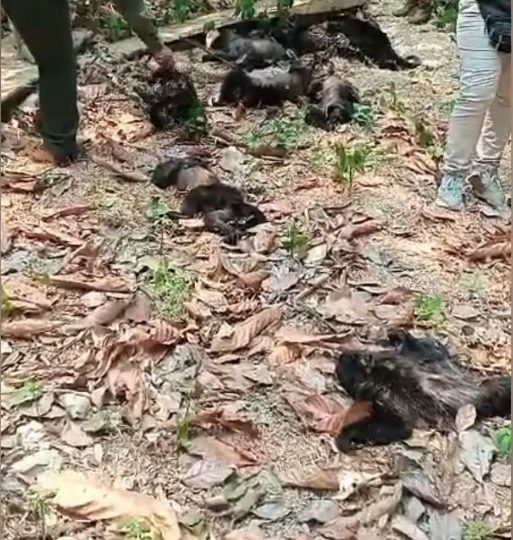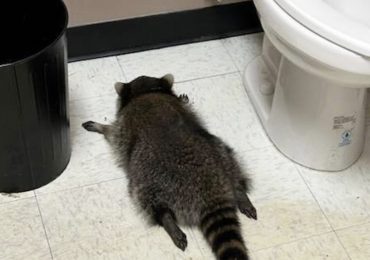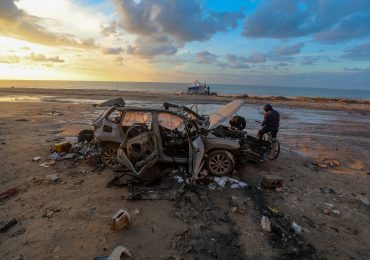AT least 138 monkeys have been killed by extreme heat, falling from trees already dead amid the brutal 46 degree Mexican heatwave.
The deaths happened over just six days where the creatures dropped “like apples” as locals frantically battled to save them.
NewsflashAt least 138 howler monkeys have dropped drop dead from trees amid a sweltering heatwave in Mexico[/caption]
APVets are battling to save as many of the creatures as they can[/caption]
APHere a soldier removes one of the dead monkeys[/caption]
APA veterinarian feeds a young howler monkey with heatstroke[/caption]
The lifeless bodies of the howler monkeys – who are known for their roaring vocal calls – have been found dead in the Gulf Coast state of Tabasco since May 16.
Five of the creatures were rushed to a local veterinarian who tried to revive them, according to the Biodiversity Conservation of The Usumacinta group.
They arrived in critical condition, with dehydration and fever, said Dr. Sergio Valenzuela. “They were as limp as rags. It was heatstroke.”
While Mexico‘s sweltering heatwave has been linked to the deaths of at least 26 people since March, veterinarians and rescuers say it has killed dozens and perhaps hundreds of the primates.
Around a third of the country saw highs of 45 degrees celsius on Tuesday.
In the town of Tecolutilla, Tabasco, the dead monkeys started appearing Friday, when a local volunteer fire-and-rescue squad showed up with five of the creatures in the bed of a truck.
Normally quite intimidating, howler monkeys are muscular and some can be as tall as 90 centimetres, with tails just as long.
Some males weigh more than two stone and can live up to 20 years.
They are equipped with big jaws and a fearsome set of teeth and fangs but are most famous for their loud lion-like roars.
Valenzuela said on Monday: “They (the volunteers) asked for help, they asked if I could examine some of the animals they had in their truck.”
He added: “They said they didn’t have any money, and asked if I could do it for free.”
The veterinarian put ice on their limp little hands and feet, and hooked them up to IV drips with electrolytes.
So far, the rescued monkeys appear to be on the mend and are being kept in cages at Valenzuela’s office.
They are said to be recovering, aggressive and biting again which, according to the expert, is a healthy sign for the usually expressive creatures.
But, most aren’t so lucky.
Wildlife biologist Gilberto Pozo counted about 138 of the animals dead or slowly dying on the ground under trees.
The string of fatalities began around May 5 and hit its peak over the weekend.
“They were falling out of the trees like apples,” Pozo said.
NewsflashHere a dehydrated baby monkey is given some fruit[/caption]
AFPThe monkeys are said to be regaining strength and becoming more feisty which is consistent with their character[/caption]
AFPThe monkeys arrived to the vets in a ‘critical condition’ with dehydration and fever[/caption]
APSome of the fortunate monkeys that have been rescued pictured recovering at the vets[/caption]
“They were in a state of severe dehydration, and they died within a matter of minutes.”
Already weakened, Pozo explained how the monkeys plummet from dozens of meters up which will kill them if they aren’t already dead from heatstroke.
He attributes the deaths to a combination of things including high heat, drought, forest fires and logging that deprives the monkeys of water, shade and the fruit they eat.
But he did note that a pathogen, disease or other factor can’t yet be ruled out.
For people in the steamy, swampy, jungle-covered state of Tabasco, the howler monkey is a cherished species.
Locals say the monkeys tell them the time of day by howling at dawn and dusk.
Pozo hears of farmers try to help the monkeys they see on their land by leaving them water and fruit but he thinks that could be a double-edged sword.
He said: “They want to care for them, mainly the baby monkeys, adopt them.
“But the truth is that babies are very delicate, they can’t be in a house where there are dogs or cats, because they have pathogens that can potentially be fatal for howler monkeys.”
Ponzo added that they must be rehabilitated and released into the wild.
They were in a state of severe dehydration, and they died within a matter of minutes
Gilberto Pozo
The biologist’s group has set up a special recovery stations for monkeys and it currently holds five monkeys, but birds and reptiles have also been affected.
He’s trying to organise a team of specialised veterinarians to give the primates the care they need.
The federal government acknowledged the problem Monday, with President Andrs Manuel Lpez Obrador saying he had heard about it on social media.
He congratulated Valenzuela on his efforts and said the government would seek to support the work.
Lpez Obrador acknowledged the heat problem saying he had never felt it as bad as this but that he has a lot of human problems to deal with as well.
By May 9, at least nine cities in Mexico had set temperature records, with Ciudad Victoria in the border state of Tamaulipas clocking a broiling 47 degrees Celsius.
With below-average rainfall throughout almost all the country so far this year, lakes and dams are drying up, and water supplies are running out.
NewsflashA desperately thirsty monkey is served with water[/caption]
AFPHowler monkeys are considered endangered[/caption]
NewsflashTemperatures soared to 45 degrees Celsius in Mexico[/caption]
Howler monkeys
Howler monkeys are medium-sized primates who are known for their impressive roar. Here are some facts about them:
Howler monkeys can be found in southern Brazil, Paraguay, eastern Bolivia, and northern Argentina
They hardly ever leave the treetops and don’t move far each day
Howlers mainly eat a diet of leaves, fruit, nuts and flowers
Their average lifespan is between 15 to 20 years old
They are one of the loudest land animals and can be heard 3 miles away
Male howlers can weigh more than two stone









